The Ruger .22RF Trials Cadet Rifle
This rifle, now held in the National Firearms Collection at the Royal Armouries in Leeds, is the pattern example of those submitted for the 2015 trials for the latest British small-bore Cadet Rifle.
Photography by courtesy of the Trustees of the Royal Armouries, being shared copyright with www.rifleman.org.uk

This particular Ruger rifle was submitted as the pattern for the trials rifles on behalf of Sturm, Ruger & Co., Inc., by the British agents,
Viking Arms. Whilst probably the more substantial rifle of the North American options, the eventual winner,
partly on a cost basis for both the rifles and the associated maintenance contract,
was the Savage Arms supplied modified version of their FVT Mk.I/II rifle.

That Savage rifle has now taken its place in the line of British training rifles,
and has been given the nomenclature L144A1 Cadet Small Bore Target Rifle (CSBTR).
The .22 long-serving rimfire training rifle now replaced was the superbly built and performing Lee-Enfield Rifle No.8, introduced in 1948.
This Ruger rifle is a modified version of their Model 8301, with its green composite stock carrying an alternative butt section,
and with the addition of a tunnel fore-sight that takes a selection of interchangeable elements, and a Williams alloy aperture target rear-sight.
Bolt closed.
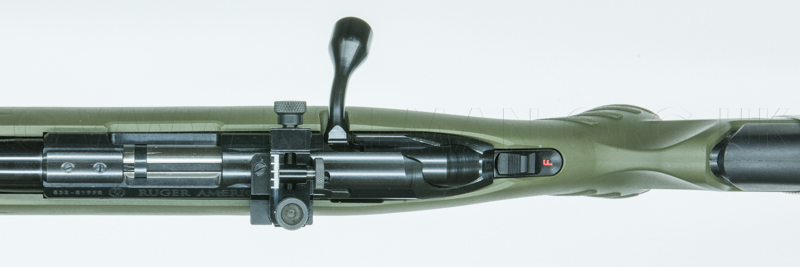
Bolt open

The standard Model 8301 is a 10-round magazine-fed rifle, but the British Forces requirement was for a single-shot weapon,
and the magazine-well has therefore been fitted with a magazine-shell
which contains a single-loading platform that is removeable only by a unit armourer.

The Williams rear-sight is identical to that fitted to the aforementioned Savage submission that eventually topped the trials.
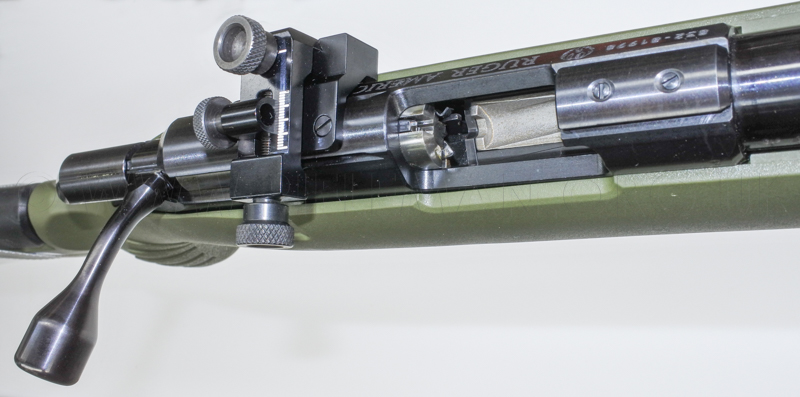
However, we have been passed some detail of the trials, for which we are most grateful,
by a Company SSI of the Surrey Army Cadet Force who was involved in the proceedings.
He advised us that .........
" The trials were organised and managed by the Infantry Trials and Development Unit, which normally deals with any small-arms trials and testing for the Army. They were held at the Gordon’s school indoor range, down the road from Bisley and Pirbright, over a two week period. There was a mix of Army Cadet Force, Combined Cadet Force and Air Training Corps adult volunteers involved in the trials. The testing was conducted using Eley Tenex.22 rimfire ammunition, and involved accuracy testing from a rest, free-hand, and with both the supplied single-point sling and various after-market target rifle slings. The specification required there to be a sling for carriage and a shooting sling, which last could be provided as a single-point type. This resulted in a number of submissions being supplied with both a single-point sling for shooting and a two-point sling for carriage. Out of all the entries the only substantial sling was provided with the two Sako Quads; all the rest, including the Ruger and the Savage rifles had horrendous luggage-strap-type slings which were fine for carriage but useless for shooting. In the case of the Ruger (the only one of the submissions that did not include an accessory rail and target-style hand stop) the use of a shooting sling was almost impossible.
" The trials rifles themselves were fitted with black composite stocks, rather than the green version used on the pattern rifle.The primary reason the Ruger did not score particularly highly was actually due to the sights, or rather their positioning. Although they are identical to the sights used on the Savage, due to the Ruger’s lower dovetail (designed for mounting scopes), you couldn’t physically get your cheek position low enough to see through the rear sight properly. One ended up with a partial sight picture that was not conducive to good accuracy. This could easily have been rectified by some raiser blocks, which fact would have been fed back to Ruger as part of the trials feedback."
Unlike the Savage rifle's bright red plastic single-loading platform, the Ruger has a rather more subtle and business-like fitting.
The bolt-release catch can be seen just behind the rear-sight mount on the left-hand-side of the action body.
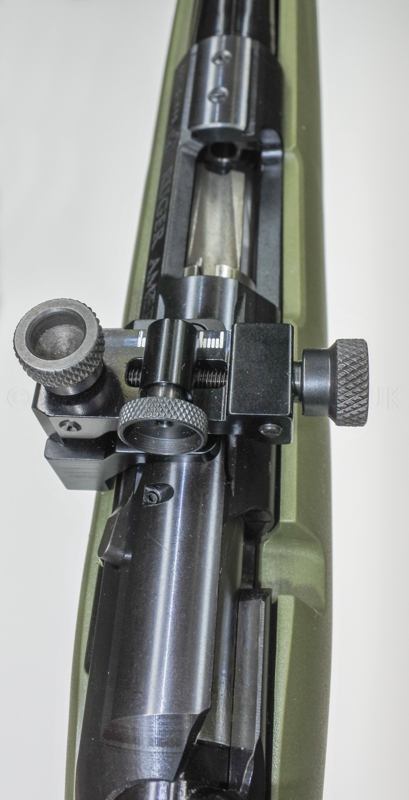
Below: the heavy rolled marking on the barrel carries the nowadays familiar
and all but obligatory P.C. safety warning applied to so many products.
"BEFORE USING FIREARM - READ INSTRUCTION MANUAL"
along with the company's Mayodan, North Carolina address.
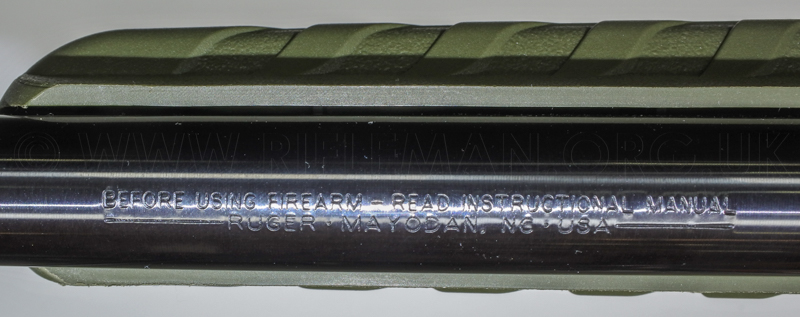
The cast alloy tubed fore-sight, on its barrel dovetail block.
As would be expected, the sight takes separate elements very similar to the
much earlier steel designs of the BSA No.20 and the Parker-Hale FS2 models.
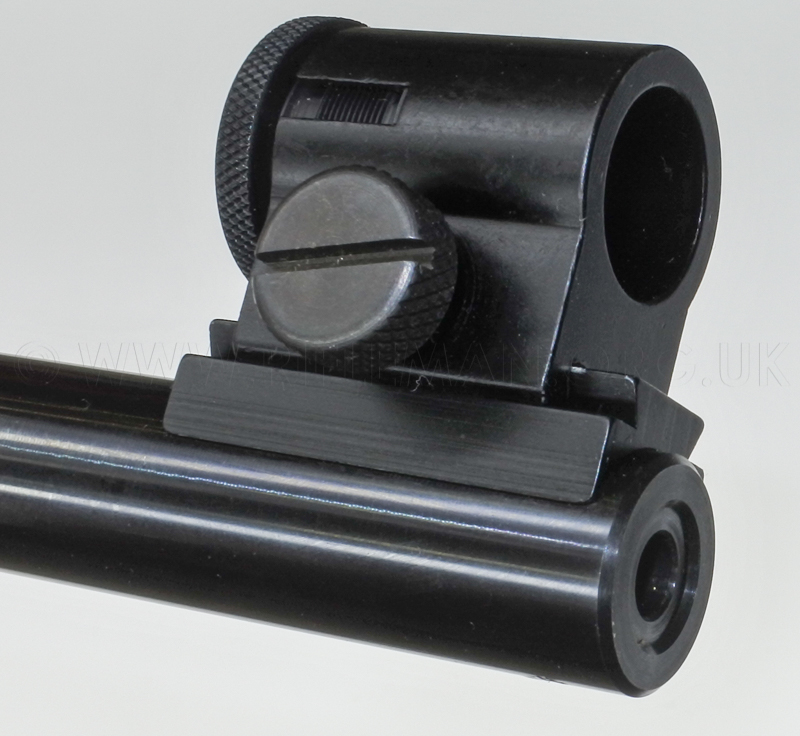
The composite padded synthetic rubber combined butt-plate and cheek-piece is impressed with the Ruger logo ........
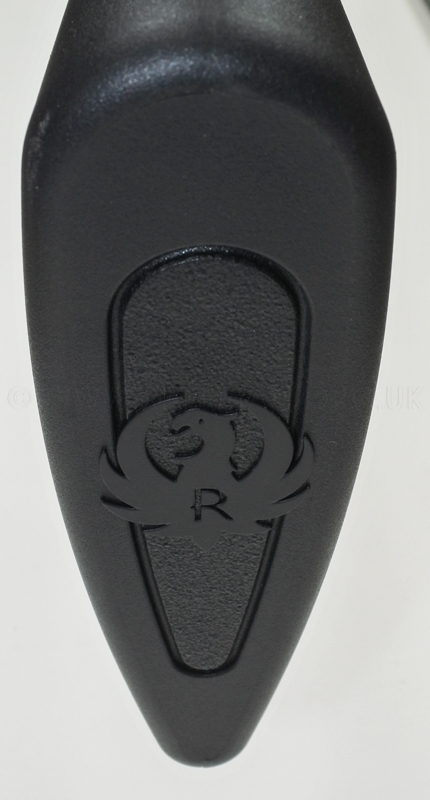
....... as is the blanking plug for the magazine-way, now converted for single-loading ...........
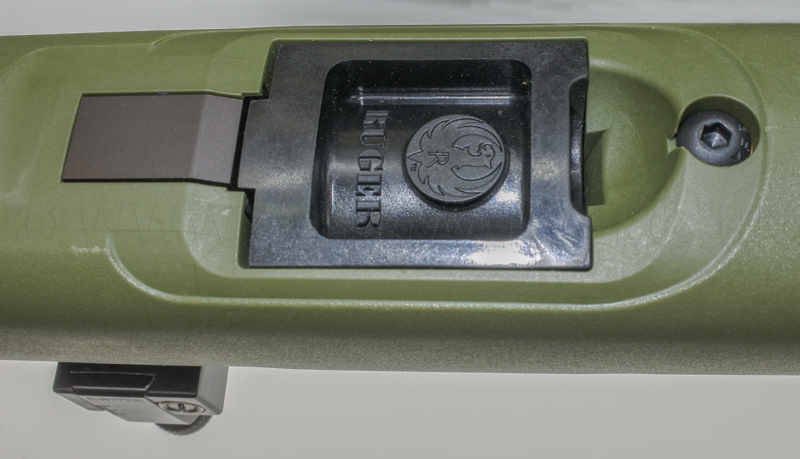
and a rather more prominent representation on the base of the pistol-grip .
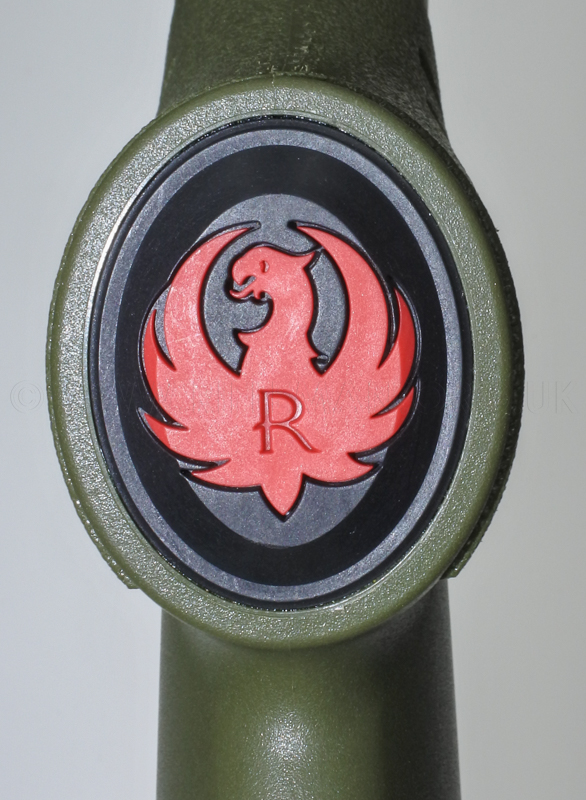
The left hand side of the action body is engraved with the familiar " RUGER AMERICAN" titling, and the serial number.
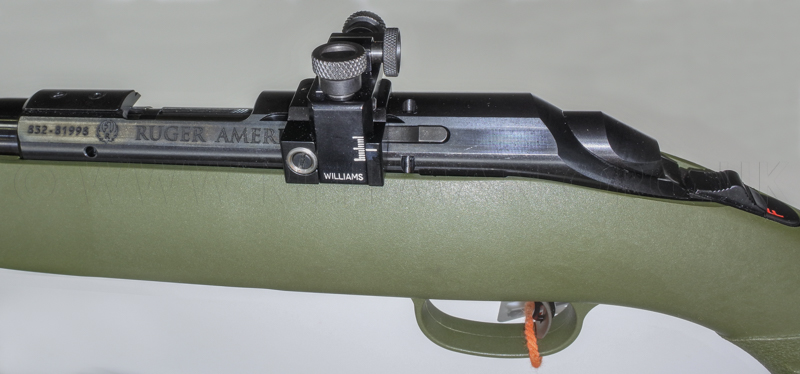
The Ruger "Marksman" safety trigger is the equivalent of the Savage Ams "Accu-trigger".
A "RIFLESHOOTER" review said of the Marksman adjustable trigger
" It is the trigger, among other features, that sets the Ruger American apart from , firstly, many other low-end rifles and, secondly, from the Savage AccuTrigger that set the bar for the modern sporting-rifle trigger. Like the AccuTrigger — to which the Ruger's trigger was immediately compared when it was introduced — the Ruger Marksman Adjustable trigger employs a release lever in the shoe, but unlike similar designs, this release locks the trigger, not the sear, so no matter how low you set the spring, the sear cannot trip.
Adjustment is accomplished by screw in the front face of the trigger assembly. Adjustment range is a claimed three to five pounds; it was possible to adjust the sample rifle's trigger to three pounds, three ounces; and as a test the adjustment screw was turned all the way out — and we were able to verify Ruger's claim that the sear won't trip no matter how light the spring is adjusted.
The pull on the Marksman Adjustable is decent but not great because it's got a little bit of creep in it, but the pull weights are consistent. Average pull weight as delivered was three pounds, 12 ounces for 10 pulls on a Lyman digital scale, and the weight never varied by more than two ounces.
The pattern rifle has Ruger's coding label affixed under the fore-end
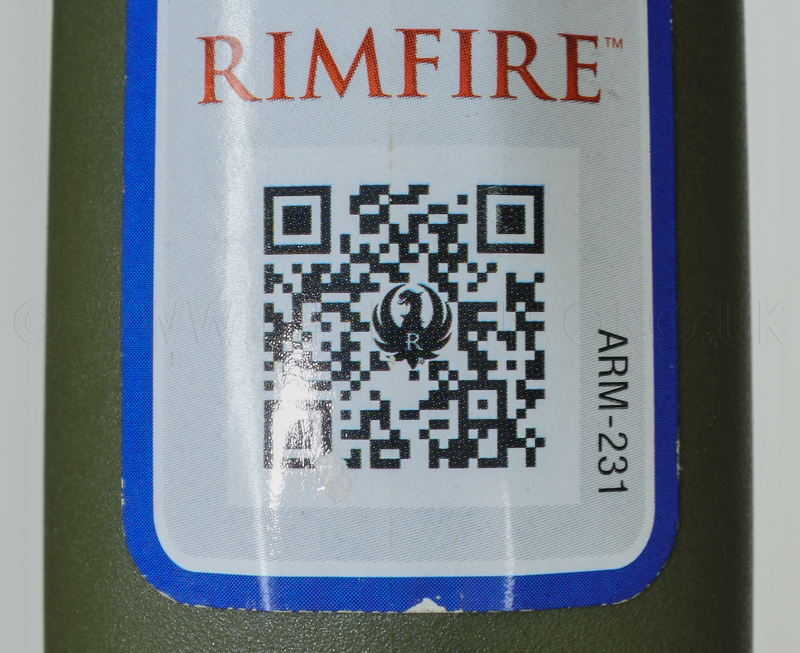
And the feature advertising label on the right-hand-side of the butt-stock.
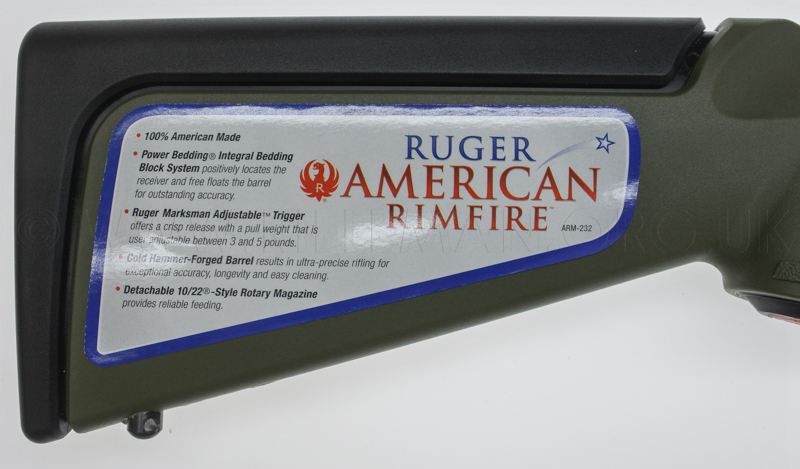
The fore-and-aft sliding shotgun-style tang safety catch is at the rear of the action.
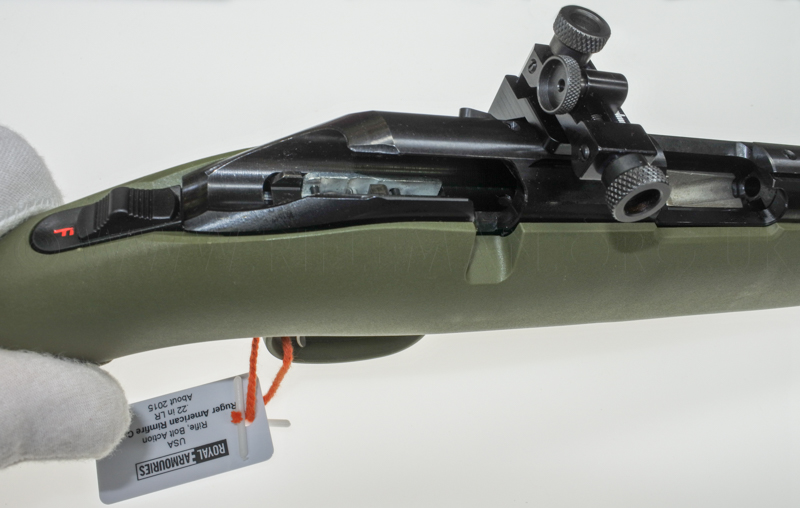
The boltway, with the bolt removed, showing the top of the trigger mechanism.
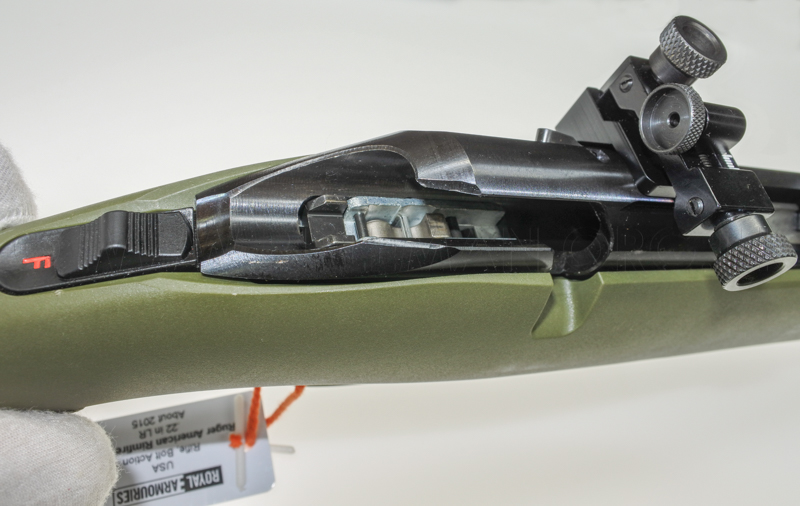
Here follow several views of the bolt itself.; first from above, showing the quickly replaceable striker/firing-pin in its slot.
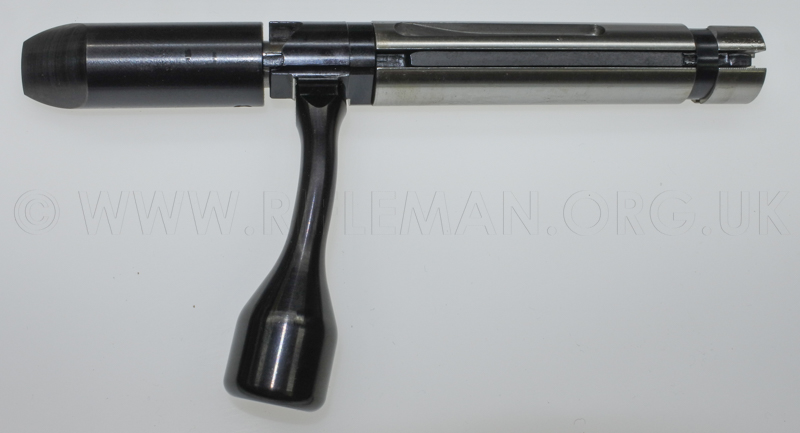
From below; with the proof mark.
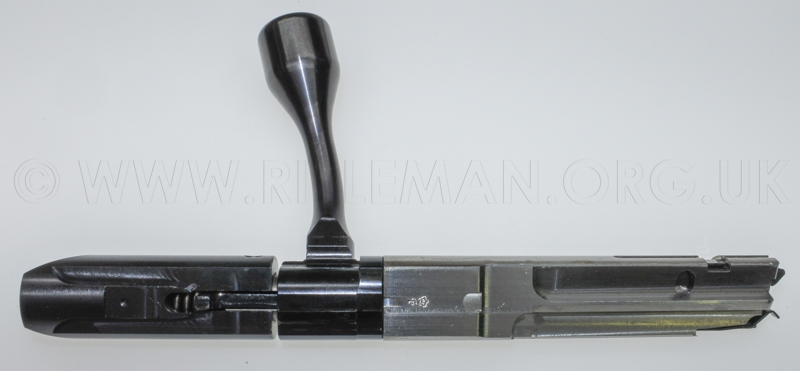
And the bolt-head face from above and below, showing the extractor lever and the sprung ejector leaf.
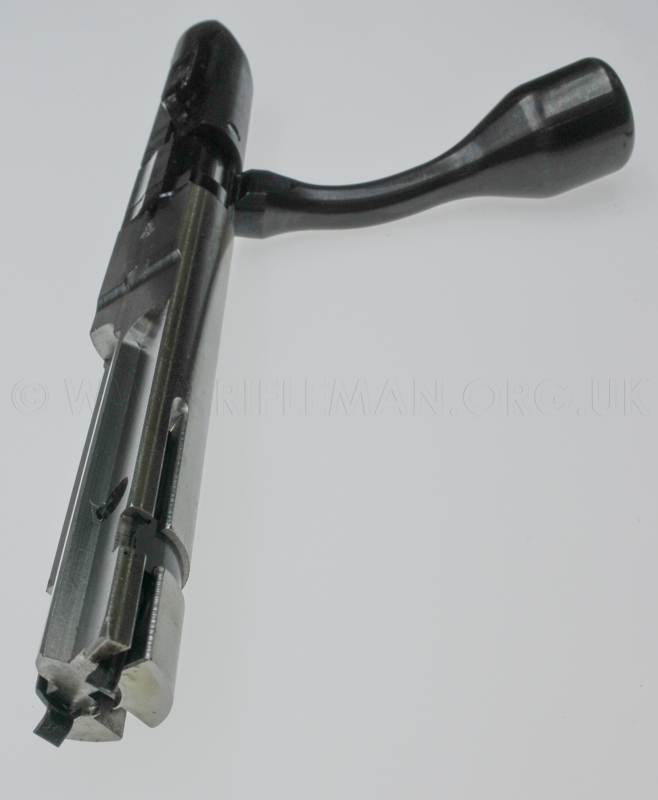
The firing-pin is held into the machined groove in the top of the bolt body, at its forward end,
by a spring-steel circular clip, in much the same way as that of the Savage submitted rifle.
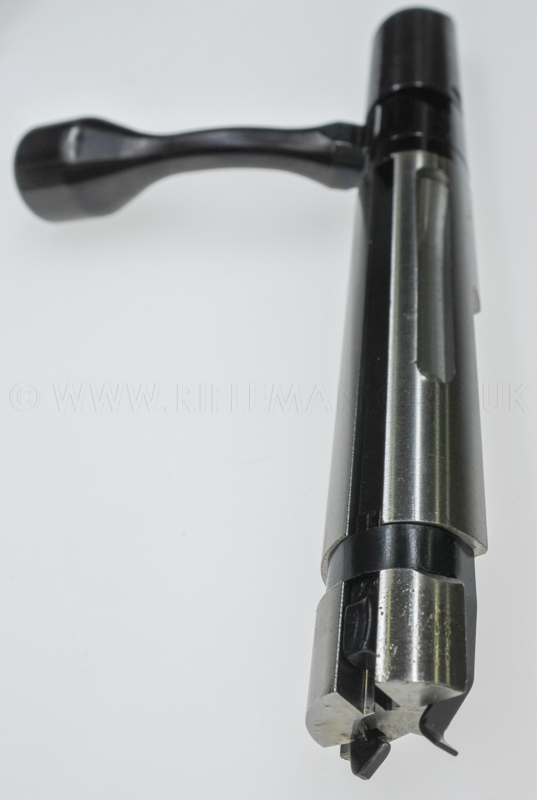
See also: theL144A1 Cadet Small Bore Target Rifle (CSBTR).
and the long-serving Lee-Enfield Rifle No.8training rifle.
Click here to access a Chronology of Enfield genre Training Rifles, Adapters & Cartridges
Return to: TOP of PAGE
See this website's Raison d'être